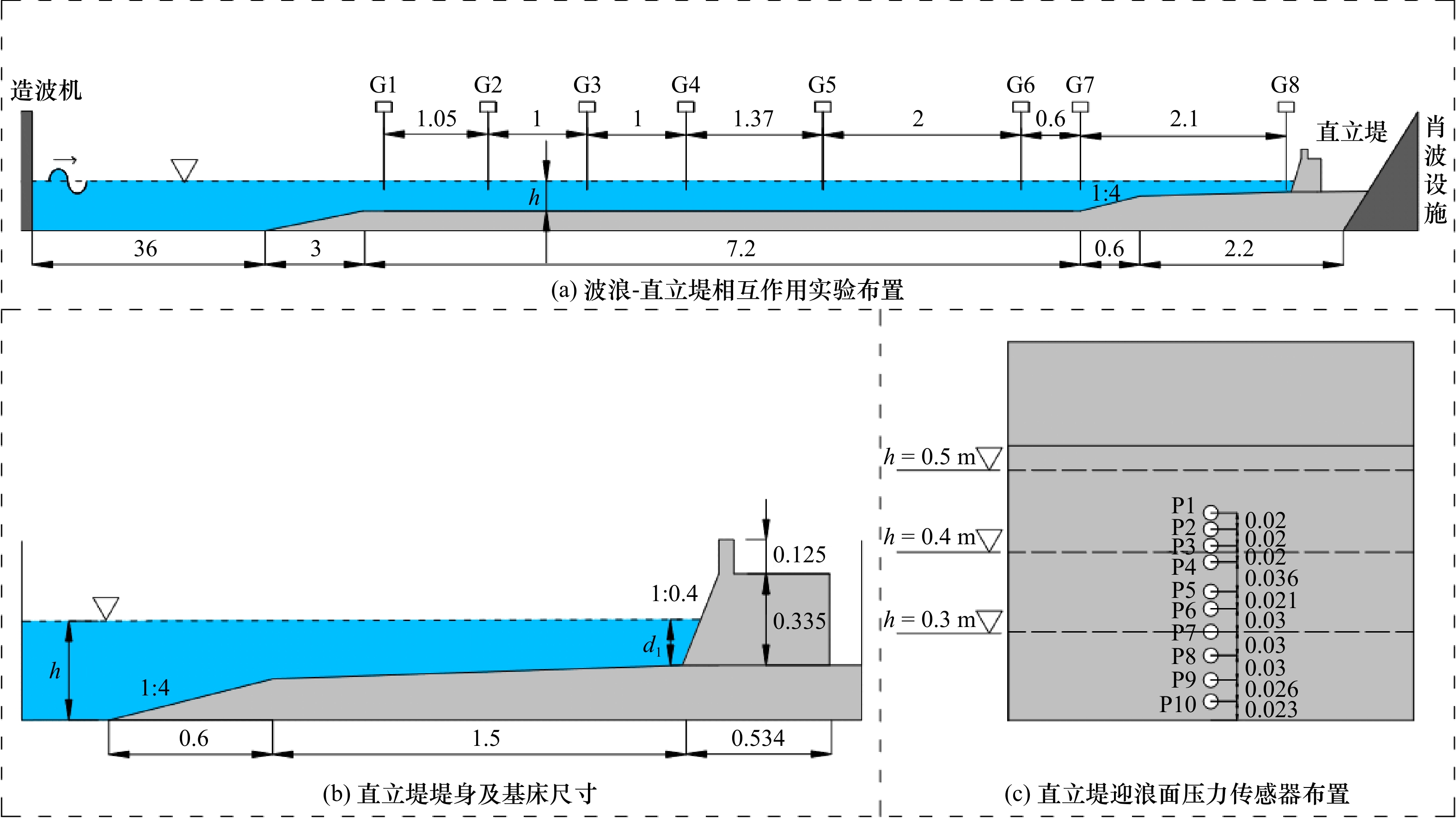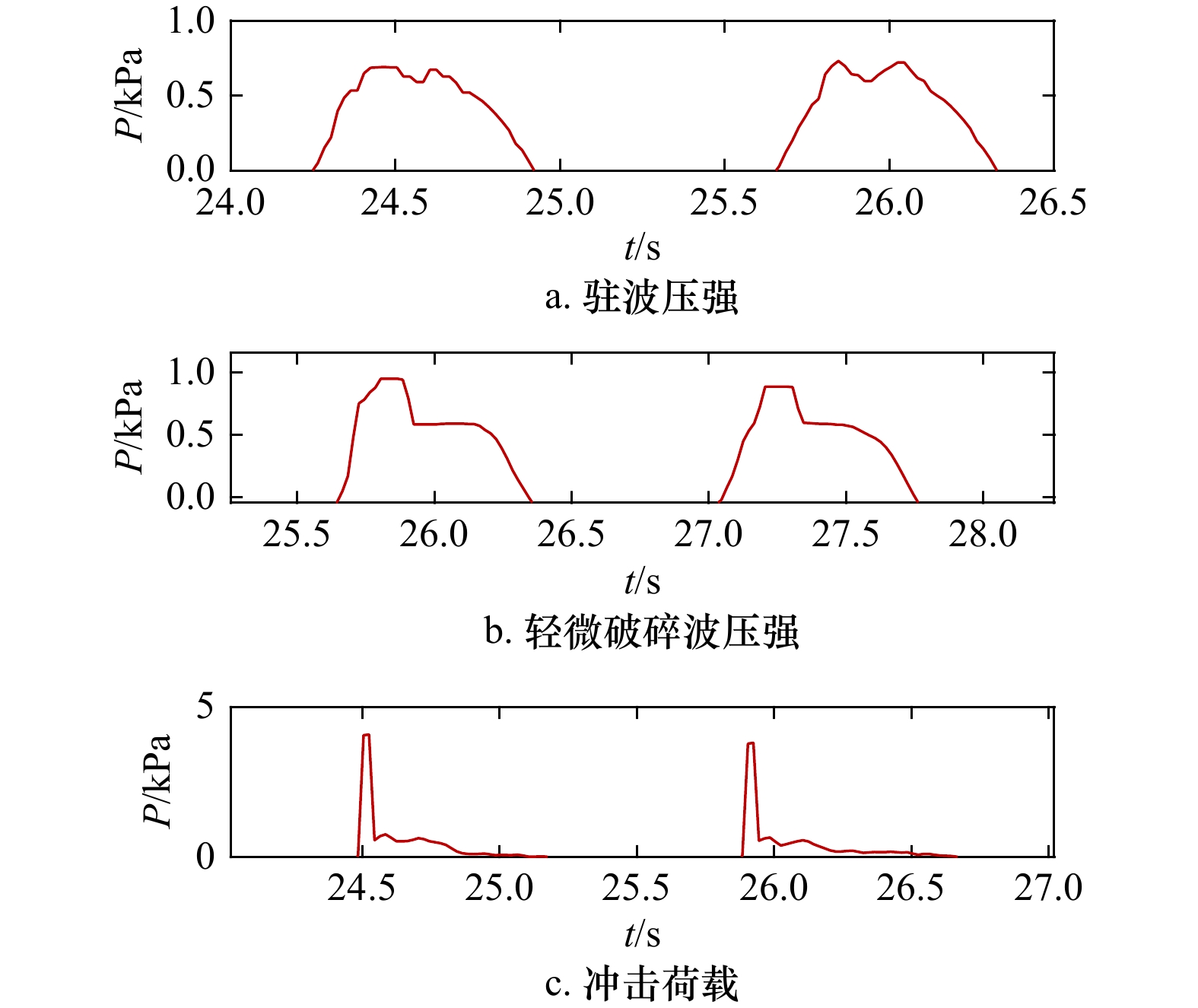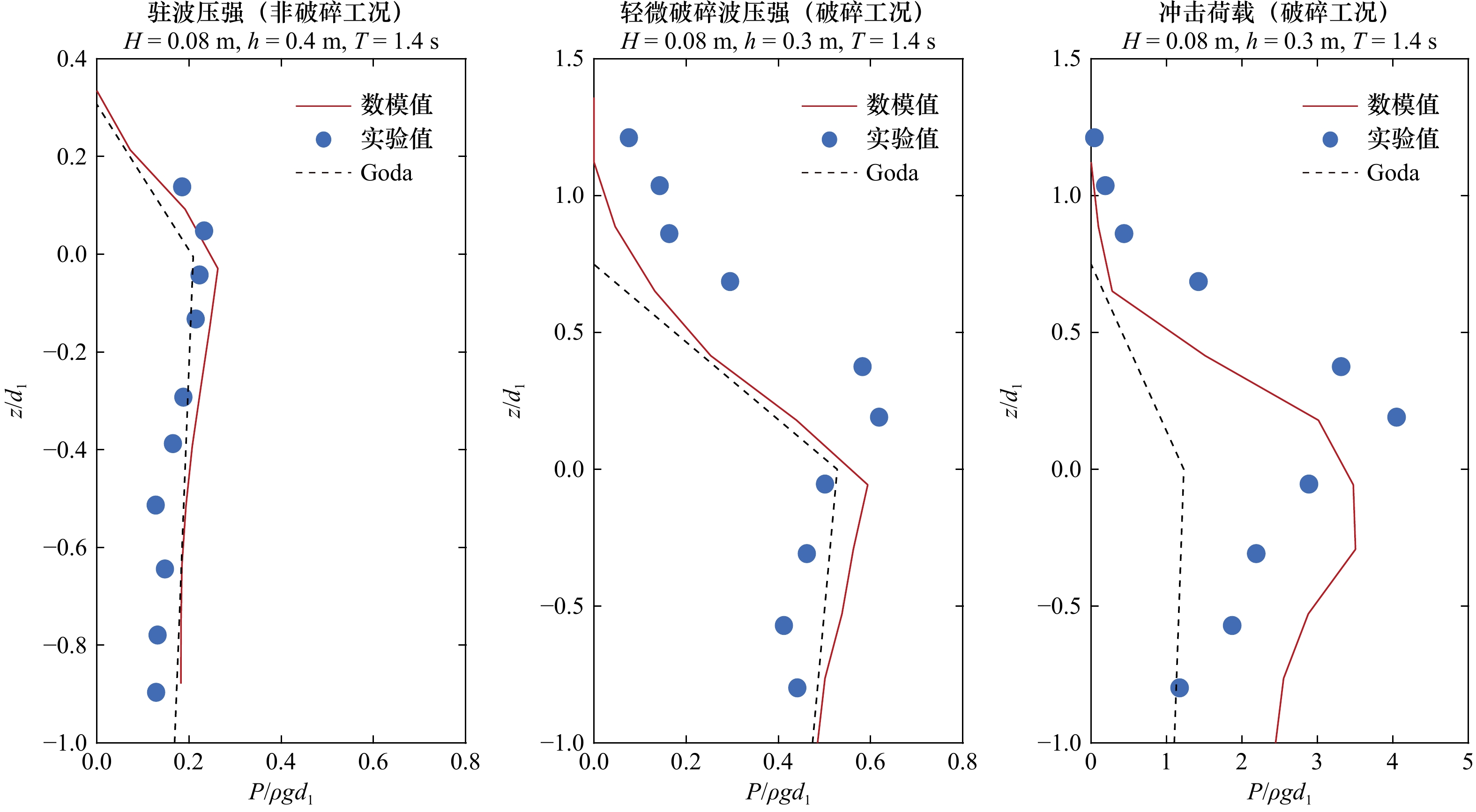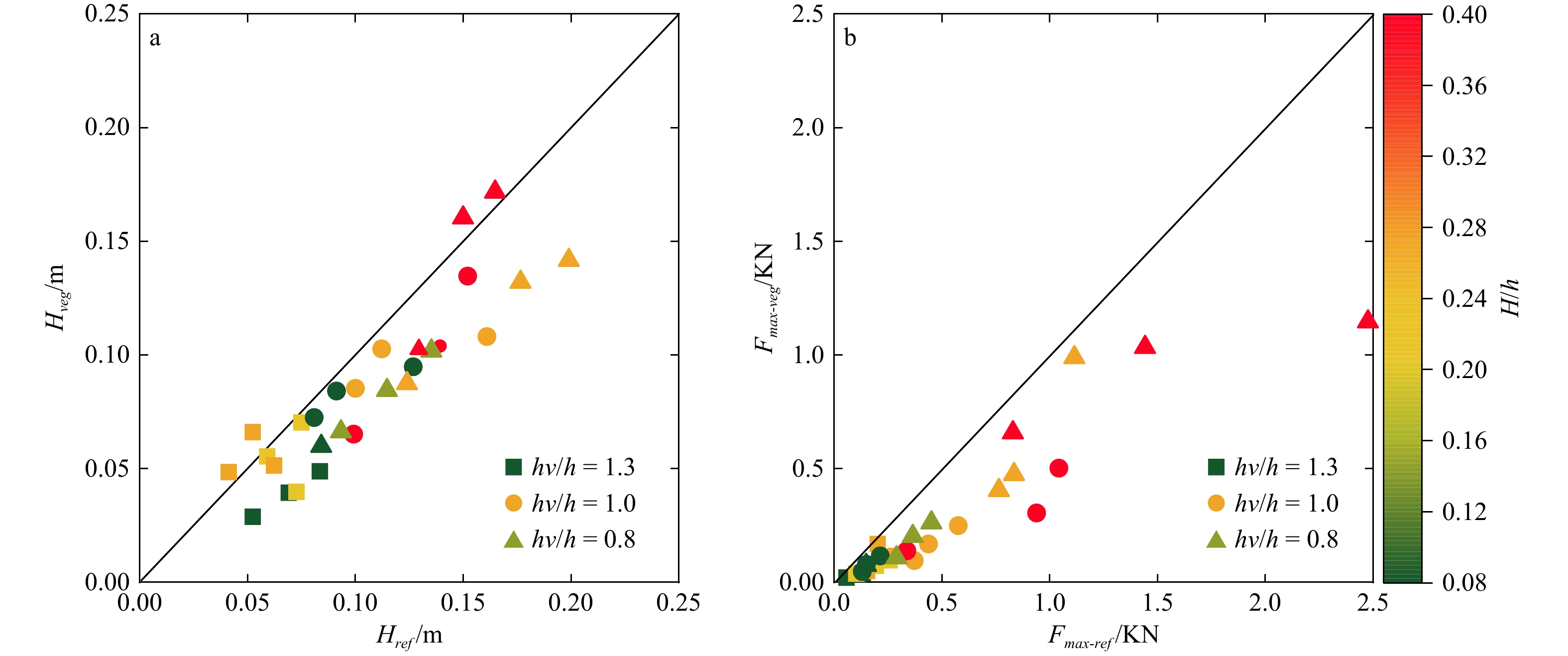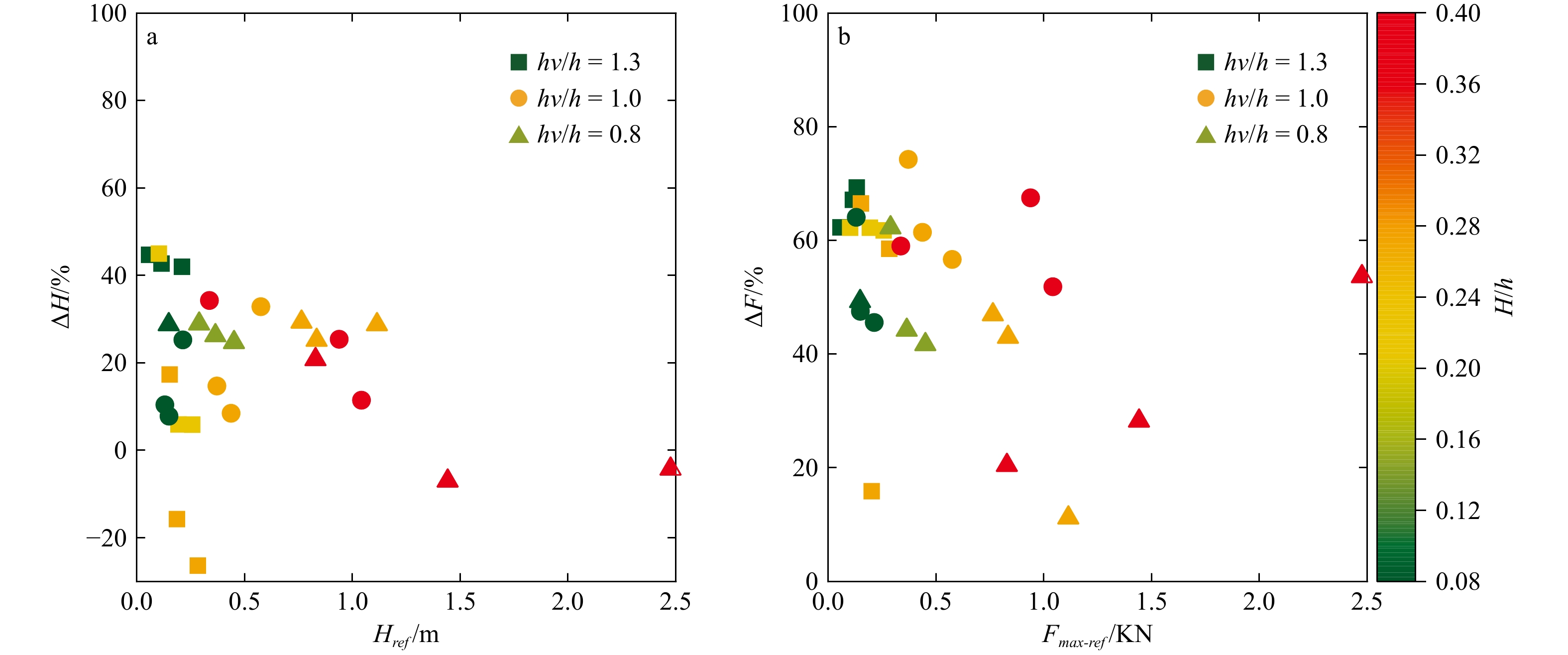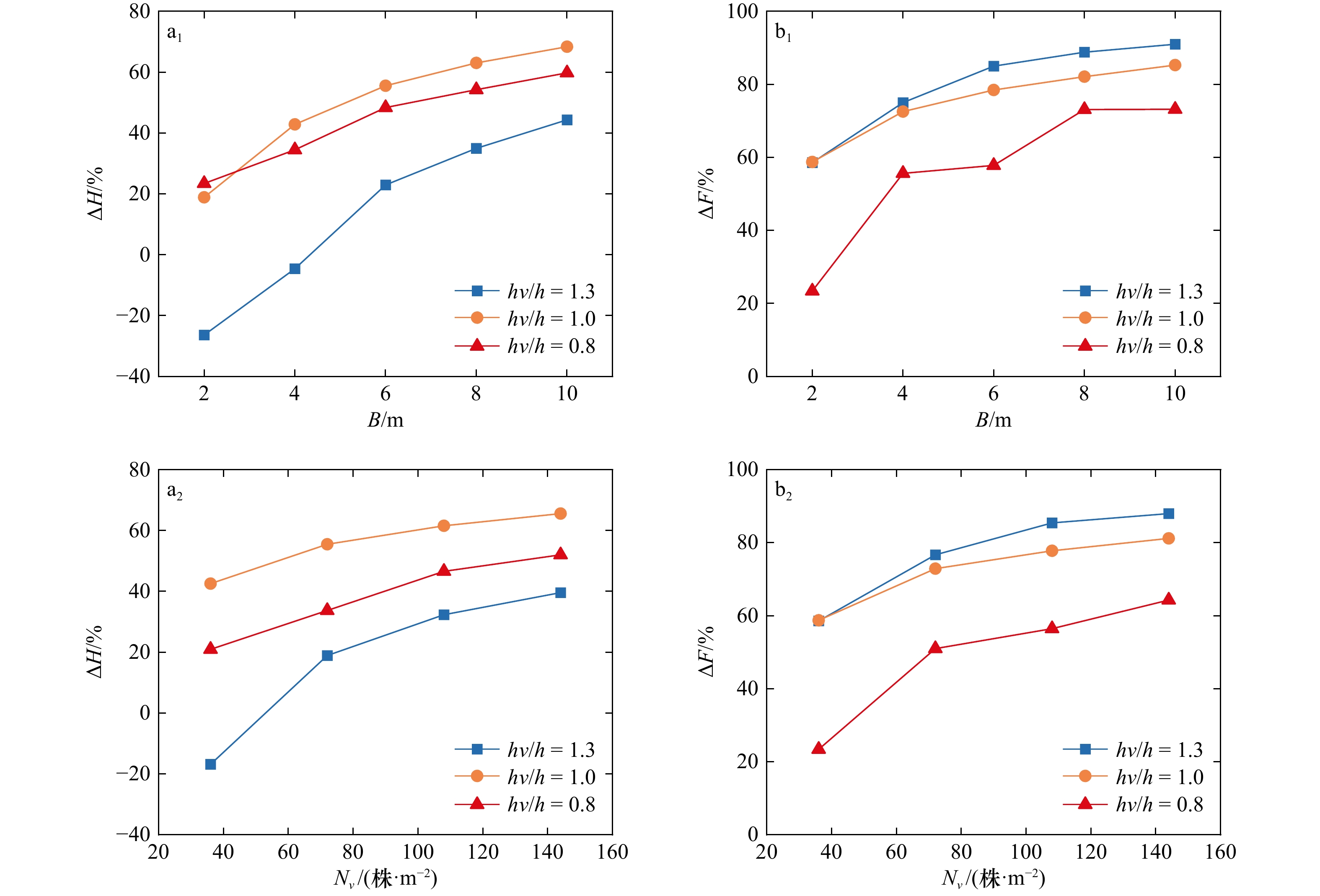Numerical simulation on the impact of mangroves on wave pressure on vertical sea dikes
-
摘要: 基于非静压模型SWASH,建立数值波浪水槽,通过设置有无红树林的对比实验,系统研究了波浪-红树林-直立堤相互作用时的水动力特性,并分析了波陡、相对水深、厄塞尔数、红树林长度、密度、特征直径等因素对直立堤堤前波高、迎浪面最大波压力的影响。研究结果表明:无红树林时Goda公式无法准确估算直立堤上的冲击荷载;在模型比尺为1∶10的数值实验中,2 m宽的堤前红树林可使波高衰减6%~45%,波压力衰减11%~74%,然而,在相对波高较大且红树林特征参数较小时会引起堤前波高增大4%~26%;在本文考虑的水力条件下,最大波压力随波陡减小而减小58%~93%,随相对水深增大而减小42%~72%,随厄塞尔数减小而减小87%~96%;堤前波高和波压力衰减率随红树林宽度、密度及特征直径的增加而非线性增加。研究结果可为进一步认识红树林的消浪效应及红树林生态系统与海堤组合的海岸防护工程的设计与规划提供科学的依据。Abstract: Based on the non-hydrostatic model SWASH, a numerical wave flume was established to systematically investigate the hydrodynamic characteristics of the interaction between waves, mangroves, and vertical sea dikes through a comparative experiment with and without mangroves. The study analyzed the influence of factors such as wave steepness, relative water depth, Ursell number, mangrove length, density, and characteristic diameter on the wave height in front of the sea dike and the maximum wave pressure on the windward side of the sea dike. The results indicate that in the absence of mangroves, the Goda formula cannot accurately estimate the impact load on the vertical sea dike. In a numerical experiment with a model scale of 1:10, a 2-meter wide mangroves in front of the dike was observed to reduce wave height by 6% to 45% and wave pressure by 11% to 74%. However, in conditions with relatively large wave heights and smaller characteristic parameters of the mangrove, an increase in the wave height in front of the dike by approximately 4% to 26% was noted. In the hydraulic conditions considered in this study, the maximum wave pressure decreased by 58% to 93% with a decrease in wave steepness, by 42% to 72% with an increase in relative water depth, and by 87% to 96% with a decrease in the Ursell number. The attenuation rates of wave height and wave pressure in front of the dike non-linearly increased with the increase in the width, density, and characteristic diameter of the mangroves. These findings provide a scientific basis for a deeper understanding of the wave-damping effects of mangroves, as well as for the design and planning of coastal protection projects combining mangrove ecosystems with sea dikes.
-
Key words:
- mangroves /
- vertical sea dike /
- wave pressure /
- numerical simulation
-
表 1 红树林区域的波浪传播变形验证工况
Tab. 1 Verification conditions for wave propagation in Mangroves
工况 水深h/m 波高H/m 周期T/s $ {C}_{D}( $V1) $ {C}_{D}( $V2) A1 0.3 0.06 1.2 3.6 7.6 A2 0.3 0.06 1.4 3 6.1 A3 0.4 0.08 1.4 2.7 5.4 A4 0.4 0.08 1.6 2.3 4.5 A5 0.5 0.12 1.4 2.1 4.2 A6 0.5 0.12 1.6 1.8 3.5 表 2 实验工况的参数设置
Tab. 2 Parameter settings of experimental conditions
序号 模型 水深h/m 波高H/m 周期T/s 植物宽度B/m 植物密度Nv/(株·m−2) 植物特征直径Dv/m M1 无红树林 0.3 0.04、0.06、0.08 1、1.4、1.8 − − − 0.4 0.06、0.10、0.14 1、1.4、1.8 − − − 0.5 0.04、0.06、0.08、0.14、0.2 1、1.4、2.0 − − − M2 有红树林 0.3 0.04、0.06、0.08 1、1.4、1.8 2 36 0.06 0.4 0.06、0.10、0.14 1、1.4、1.8 2 36 0.06 0.5 0.04、0.06、0.08、0.14、0.2 1、1.4、2.0 2 36 0.06 M3 有红树林 0.3、0.4、0.5 0.08 1.4 2、4、6、8、10 36 0.06 M4 有红树林 0.3、0.4、0.5 0.08 1.4 2 36、72、108、144 0.06 M5 有红树林 0.3、0.4、0.5 0.08 1.4 2 36 0.03、0.06、0.09、0.12 注:−表示无红树林的工况。 -
[1] Bullock G N, Obhrai C, Peregrine D H, et al. Violent breaking wave impacts. Part 1: results from large-scale regular wave tests on vertical and sloping walls[J]. Coastal Engineering, 2007, 54(8): 602−617. doi: 10.1016/j.coastaleng.2006.12.002 [2] Romolo A, Timpano B, Laface V, et al. Experimental investigation of wave loads on U-OWC breakwater[J]. Journal of Marine Science and Engineering, 2023, 11(1): 19. [3] 叶舟. 基于浙江海堤安全的海洋环境因子变化研究[J]. 海洋工程, 2021, 39(3): 127−134.Ye Zhou. Study on the impact of regional marine environmental factors on the seawall safety in Zhejiang[J]. The Ocean Engineering, 2021, 39(3): 127−134. [4] 陈君. 江苏海堤生态化建设思考与建议[J]. 中国水利, 2023(6): 33−36.Chen Jun. Thoughts and suggestion on ecological construction of seawalls in Jiangsu Province[J]. China Water Resources, 2023(6): 33−36. [5] Möller I, Kudella M, Rupprecht F, et al. Wave attenuation over coastal salt marshes under storm surge conditions[J]. Nature Geoscience, 2014, 7(10): 727−731. doi: 10.1038/ngeo2251 [6] Yang Zhiyong, Tang Jun, Shen Yongming. Numerical study for vegetation effects on coastal wave propagation by using nonlinear Boussinesq model[J]. Applied Ocean Research, 2018, 70: 32−40. doi: 10.1016/j.apor.2017.09.001 [7] Horstman E M, Dohmen-Janssen C M, Narra P M F, et al. Wave attenuation in mangroves: a quantitative approach to field observations[J]. Coastal Engineering, 2014, 94: 47−62. doi: 10.1016/j.coastaleng.2014.08.005 [8] 田野, 陈玉军, 侯琳, 等. 广东湛江无瓣海桑红树林消波效应初步研究[J]. 浙江农业科学, 2014(2): 210−213.Tian Ye, Chen Yujun, Hou Lin, et al. A preliminary study on the wave dissipation effect of mangrove forests in Zhanjiang, Guangdong Province[J]. Journal of Zhejiang Agricultural Sciences, 2014(2): 210−213. (查阅网上资料, 未找到本条文献的英文信息, 请确认) [9] Cao Haijin, Chen Yujun, Tian Ye, et al. Field investigation into wave attenuation in the mangrove environment of the South China Sea Coast[J]. Journal of Coastal Research, 2016, 32(6): 1417−1427. [10] Hu Zhan, Suzuki T, Zitman T, et al. Laboratory study on wave dissipation by vegetation in combined current–wave flow[J]. Coastal Engineering, 2014, 88: 131−142. doi: 10.1016/j.coastaleng.2014.02.009 [11] Maza M, Adler K, Ramos D, et al. Velocity and drag evolution from the leading edge of a model mangrove forest[J]. Journal of Geophysical Research:Oceans, 2017, 122(11): 9144−9159. doi: 10.1002/2017JC012945 [12] 陈杰, 赵静, 蒋昌波, 等. 非淹没刚性植物对规则波传播变形影响实验研究[J]. 海洋通报, 2017, 36(2): 222−229.Chen Jie, Zhao Jing, Jiang Changbo, et al. Laboratory investigation on the effects of emergent rigid vegetation on the regular wave transformation[J]. Marine Science Bulletin, 2017, 36(2): 222−229. [13] 何飞, 陈杰, 蒋昌波, 等. 规则波作用下植物带波高衰减特性实验研究[J]. 海洋科学进展, 2018, 36(1): 146−158.He Fei, Chen Jie, Jiang Changbo, et al. Experimental study on wave height attenuation induced by the coastal vegetation under regular waves[J]. Advances in Marine Science, 2018, 36(1): 146−158. [14] Maza M, Lara J L, Losada I J. Tsunami wave interaction with mangrove forests: a 3-D numerical approach[J]. Coastal Engineering, 2015, 98: 33−54. doi: 10.1016/j.coastaleng.2015.01.002 [15] Tang Jun, Shen Yongming, Causon D M, et al. Numerical study of periodic long wave run-up on a rigid vegetation sloping beach[J]. Coastal Engineering, 2017, 121: 158−166. doi: 10.1016/j.coastaleng.2016.12.004 [16] Yao Yu, Tang Zhengjiang, Jiang Changbo, et al. Boussinesq modeling of solitary wave run-up reduction by emergent vegetation on a sloping beach[J]. Journal of Hydro-Environment Research, 2018, 19: 78−87. doi: 10.1016/j.jher.2018.03.001 [17] Zou Xuefeng, Zhu Liangsheng, Zhao Jun. Numerical simulations of non-breaking, breaking and broken wave interaction with emerged vegetation using navier-stokes equations[J]. Water, 2019, 11(12): 2561. doi: 10.3390/w11122561 [18] Tanaka N, Sasaki Y, Mowjood M I M, et al. Coastal vegetation structures and their functions in tsunami protection: experience of the recent Indian Ocean tsunami[J]. Landscape and Ecological Engineering, 2007, 3(1): 33−45. doi: 10.1007/s11355-006-0013-9 [19] Alongi D M. Mangrove forests: resilience, protection from tsunamis, and responses to global climate change[J]. Estuarine, Coastal and Shelf Science, 2008, 76(1): 1−13. doi: 10.1016/j.ecss.2007.08.024 [20] Schoonees T, Gijón Mancheño A, Scheres B, et al. Hard structures for coastal protection, towards greener designs[J]. Estuaries and Coasts, 2019, 42(7): 1709−1729. doi: 10.1007/s12237-019-00551-z [21] Tomiczek T, Wargula A, Lomónaco P, et al. Physical model investigation of mid-scale mangrove effects on flow hydrodynamics and pressures and loads in the built environment[J]. Coastal Engineering, 2020, 162: 103791. doi: 10.1016/j.coastaleng.2020.103791 [22] Sainflou G. Essai sur les digues meritimes verticales[J]. Annales Pnots et Chaussees, 1928, 98(4): 5−48. [23] Minikin R C. Winds, Waves and Maritime Structures: Studies in Harbour Making and the Protection of Coasts[M]. 2nd ed. London: Griffin, 1963. [24] Goda Y. A new method of wave pressure calculation for the design of composite breakwaters[J]. Report of the Port and Harbour Research Institute, 1973, 12(3): 31−69. (查阅网上资料, 未找到本条文献, 请确认) Goda Y. A new method of wave pressure calculation for the design of composite breakwaters[J]. Report of the Port and Harbour Research Institute, 1973, 12(3): 31−69. (查阅网上资料, 未找到本条文献, 请确认) [25] Hsu H C, Chen Y Y, Chen Y R, et al. Experimental study of forces influencing vertical breakwater under extreme waves[J]. Water, 2022, 14(4): 657. doi: 10.3390/w14040657 [26] Kumaran V, Manu, Rao S. Assessment of dynamic pressure and wave forces on vertical-caisson type breakwater[J]. Marine Georesources & Geotechnology, 2022, 40(2): 147−158. [27] 王浩霖, 张华昌, 董胜. 直立堤上任意方向入射波的波压力研究[J]. 工程力学, 2018, 35(5): 246−256.Wang Haolin, Zhang Huachang, Dong Sheng. A study on arbitrary incident wave pressure on vertical breakwaters[J]. Engineering Mechanics, 2018, 35(5): 246−256. [28] Neelamani S, Al-Anjari N. Experimental investigations on wave induced dynamic pressures over slotted vertical barriers in random wave fields[J]. Ocean Engineering, 2021, 220: 108482. doi: 10.1016/j.oceaneng.2020.108482 [29] Gruwez V, Altomare C, Suzuki T, et al. An inter-model comparison for wave interactions with sea dikes on shallow foreshores[J]. Journal of Marine Science and Engineering, 2020, 8(12): 985. doi: 10.3390/jmse8120985 [30] Rosenberger D, Marsooli R. Benefits of vegetation for mitigating wave impacts on vertical seawalls[J]. Ocean Engineering, 2022, 250: 110974. doi: 10.1016/j.oceaneng.2022.110974 [31] Mokrani C, Abadie S, Grilli S, et al. Numerical simulation of the impact of a plunging breaker on a vertical structure and subsequent overtopping event using a Navier-stokes VOF model[C]//Proceedings of the Twentieth (2010) International Offshore and Polar Engineering Conference. Beijing: ISOPE, 2010. [32] Martin-Medina M, Abadie S, Mokrani C, et al. Numerical simulation of flip-through impacts of variable steepness on a vertical breakwater[J]. Applied Ocean Research, 2018, 75: 117−131. doi: 10.1016/j.apor.2018.03.013 [33] Zijlema M, Stelling G, Smit P. SWASH: an operational public domain code for simulating wave fields and rapidly varied flows in coastal waters[J]. Coastal Engineering, 2011, 58(10): 992−1012. doi: 10.1016/j.coastaleng.2011.05.015 [34] Morison J R, Johnson J W, Schaaf S A. The force exerted by surface waves on piles[J]. Journal of Petroleum Technology, 1950, 2(5): 149−154. doi: 10.2118/950149-G [35] Zhang Rong, Chen Yongping, Lei Jiaxin, et al. Experimental investigation of wave attenuation by mangrove forests with submerged canopies[J]. Coastal Engineering, 2023, 186: 104403. doi: 10.1016/j.coastaleng.2023.104403 [36] Zhang Xiaoxia, Lin Pengzhi, Nepf H. A simple‐wave damping model for flexible marsh plants[J]. Limnology and Oceanography, 2021, 66(12): 4182−4196. doi: 10.1002/lno.11952 [37] Brinkman R M. Wave attenuation in mangrove forests: an investigation through field and theoretical studies[D]. Townsville: James Cook University, 2006. [38] Maza M, Lara J L, Losada I J. Experimental analysis of wave attenuation and drag forces in a realistic fringe Rhizophora mangrove forest[J]. Advances in Water Resources, 2019, 131: 103376. doi: 10.1016/j.advwatres.2019.07.006 [39] Maza M, Lara J L, Losada I J. Predicting the evolution of coastal protection service with mangrove forest age[J]. Coastal Engineering, 2021, 168: 103922. doi: 10.1016/j.coastaleng.2021.103922 [40] Keimer K, Schürenkamp D, Miescke F, et al. Ecohydraulics of surrogate salt marshes for coastal protection: wave–vegetation interaction and related hydrodynamics on vegetated foreshores at sea dikes[J]. Journal of Waterway, Port, Coastal, and Ocean Engineering, 2021, 147(6): 04021035. doi: 10.1061/(ASCE)WW.1943-5460.0000667 [41] Phan L K, van Thiel de Vries J S M, Stive M J F. Coastal mangrove squeeze in the Mekong Delta[J]. Journal of Coastal Research, 2015, 31(2): 233−243. [42] Ismail H, Abd Wahab A K, Alias N E. Determination of mangrove forest performance in reducing tsunami run-up using physical models[J]. Natural Hazards, 2012, 63(2): 939−963. doi: 10.1007/s11069-012-0200-y [43] Lee W K, Tay S H X, Ooi S K, et al. Potential short wave attenuation function of disturbed mangroves[J]. Estuarine, Coastal and Shelf Science, 2021, 248: 106747. doi: 10.1016/j.ecss.2020.106747 [44] 龚尚鹏, 陈杰, 蒋昌波, 等. 海岸植物带对孤立波的波能耗散研究[J]. 海洋科学进展, 2020, 38(3): 522−531.Gong Shangpeng, Chen Jie, Jiang Changbo, et al. Solitary wave energy dissipation by coastal vegetation[J]. Advances in Marine Science, 2020, 38(3): 522−531. -





 下载:
下载:

